Feature Interview with Dana Fry
January, 2009
1. How did you get your start in golf course architecture?
In 1983 while attending the University of Arizona in Tucson and I was on the golf team. During the summer break before my senior year I met Andy Banfield who was, and still is, one of Tom Fazio’s lead designers. We started talking and he told me about a new project he was starting in town called Ventana Canyon. He invited me to take a look at the course and then offered me a part time job. I started out on his team by flagging saguaro cacti that needed to be transplanted. One thing led to another and, by the end of the summer, I decided to take a leave from college for this once in a lifetime opportunity. By U of A standards I was a marginal player so I felt this opportunity may afford me a better chance at working in the golf industry. Andy taught me to run a bulldozer and spent a lot of time sharing his thoughts on golf course design. Another thing he did was stress how important it was to see as many great golf courses as possible. At that point I put off returning to U of A even further to see the course completed. When the course was close to completion Tom Fazio offered me a full time job which I gladly accepted. Needles to say, I never graduated from college but boy did I ever get an education. Andy taught me something that to this day I really remember which was to see the big picture while thinking outside of the box. I really admire Andy because, just as Pete Dye had done, he changed golf course architecture forever. Some people may not like to admit it but he helped usher in a new era and I had a front row seat!

The opener at Devil's Pulpit, the launching point for Hurdzan and Fry.
2. Was it clear to you in the early days that Mike Strantz had another level of artistry in him?
I met Mike on my second job, which was Callawassie Island off of Hilton Head, in the summer of 1984. Mike was working on the grounds crew at Inverness in Toledo, Ohio while Fazio was making changes to the course for an upcoming U S Open. Andy Banfield was in charge of the project and was the one who befriended Mike and got him a job with Fazio. I always tell people that Andy taught me to think big, but Mike taught me to really see and visualize things. Mike also showed me how to run a bulldozer and create shapes. From the second I met Mike it was apparent that he was a very creative guy who happened to have a great dry sense of humor. He would get off his dozer with a sketch pad and draw what he wanted to shape or what he wanted me to shape. His drawings were a piece of art and he would always hide something funny in them such as Mickey Mouse waving from a bull dozer, a woman in a bikini or funny symbols. I will never forget the last time I saw him. I went to visit him a month or so before he passed away and it was obvious he didn’t have long to live. I couldn’t understand what he had to say but his wife Heidi could. I was going through a divorce and was really having a tough time. Even though Mike was close to the end of his life he was the one comforting me and telling me how proud he was of me and that he loved me. He was not only a great architect but more importantly he was a great husband, father and friend. I sure miss him!
3. How did you and Dr. Michael Hurdzan become a team?
I met Mike at the GCSAA Show in Feb. of 1988. I was at that show interviewing with Dye Designs. I ran into an unexpected issue as I thought I would be working for Pete and not Perry. After my interview I was talking to Pete and Alice when Mike walked by and the Dye’s introduced me to him. Mike asked what I was doing there and I told him I was interviewing for a job. He asked if I had made a decision and I said no. He then proceeded to tell me about this new course he was going to build in the Toronto area called the Devil’s Pulpit. He offered to fly me up to Toronto to see if I would be interested in moving there to oversee the construction of the course. This new venture came with the promise that, after it was finished, I could move to Columbus, Ohio with my family and work out of a permanent home base. Mike and I went to meet with Chris Haney who created Trivial Pursuit and was going to build the Devil’s Pulpit. You could see that both Mike and Chris wanted to create something extra special so I accepted Mike’s offer. It was by far the best business decision I have ever made. I always say Mike taught me just a little about golf but a whole lot about life. I can honestly say that Mike is one of my best friends in the world and a person who I look up to and admire more that anyone. I was very lucky to meet him and I owe it all to Pete and Alice Dye!
4. You have traveled extensively across the United Kingdom “ were any particular links in your mind when you worked on Devil’s Paintbrush?
One day while we were building Devil’s Pulpit the owner, Chris Haney, asked me to take a ride with him. He said he had something to show me. He parked his car on the road along what is now the 7th fairway of Devil’s Paintbrush. We walked to the top of a little hill and my jaw just dropped. You could see almost the entire sight from that spot. The natural contours were amazing. Planning started right away and that next spring I went over to Scotland on my first trip with the superintendent Ken Wright. We spent about 2 weeks touring Scotland, playing golf and looking at a lot of courses. It was St. Andrews that stuck with me the most. At the time St. Andrews was rebuilding the sod wall bunkers for the upcoming British Open. Walter Woods, the superintendent at the time, personally showed us how they built those bunkers. That is where the idea of the sod wall bunkers at the Devil’s Paintbrush came from. Many people told us they wouldn’t last and it would be a problem. The bunkers were built in 1990 & 1991, so they have been there for almost 20 years now. The Paintbrush will always have a very special place in my heart.
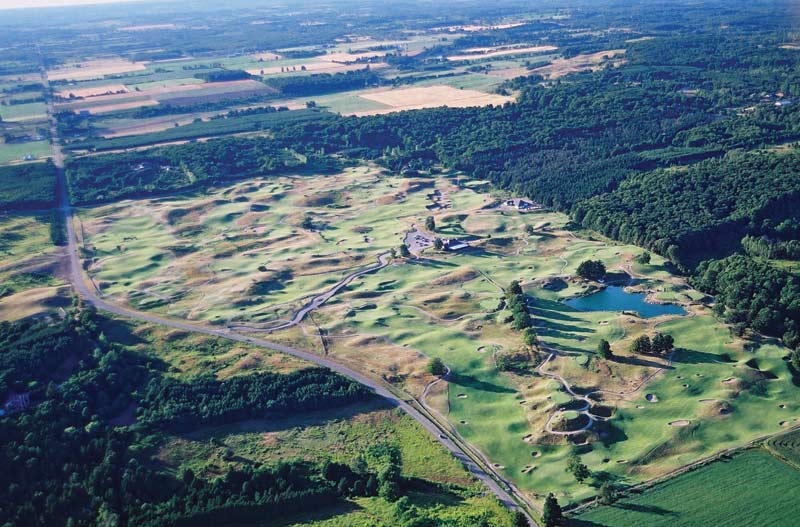
The follow up to the Pulpit - the inspired Devil's Paintbrush.
5. What grasses were employed at the Paintbrush? How important were they to how the course now plays?
Mike Hurdzan fought hard to make the course all fescue. At the time I disagreed with him and thought the course wouldn’t look right. It sure shows how little I knew because Mike was definitely right. He believed that for the course to really play like a links course it needed to be all fescue including the greens. Almost everyone told him that fescue wouldn’t work but he was relentless about it. Finally the decision was made by the owner that the entire course would be fescue with the exception of the greens. The greens were Penncross bentgrass while everything else was planted to a combination of fine fescue, slender creeping red fescue and hard red fescue. The grasses chosen complete the experience at the Paintbrush. It plays very hard and fast most of the year so going to all fescue was definitely the correct decision.
6. Discuss the evolution of the seventeenth hole, which is one of the most fascinating, multi-option holes we have ever seen.
I believe the hole we are referring to is the par 5, 8th with the old house ruins in the middle of the landing area. When the course originally opened it played as #17. Several years back the owner switched the 9’s so that the course would finish out behind the clubhouse. That hole has always been one of my favorites. The view from the tee is awesome with the entire course laid out before you with the CN Tower and downtown Toronto off in the distance. The tee shot is downhill and you must decide to play left or right of the old house foundation which sits in the center of the fairway. We left that foundation as well as an old root cellar and old water trough that animals used to drink from. After the tee shot you hit over a sod wall that stretches nearly all the way across the fairway. It is over 60 yards wide and in spots up to 15 feet high. From the prime landing area one must decide to go for the green, which is very small and is guarded by a huge natural depression on the front left of the green and a huge natural mound to the right. The opening between the two is very small. It is a very risky shot with lots of trouble around it but is fun to try and knock it on in two.
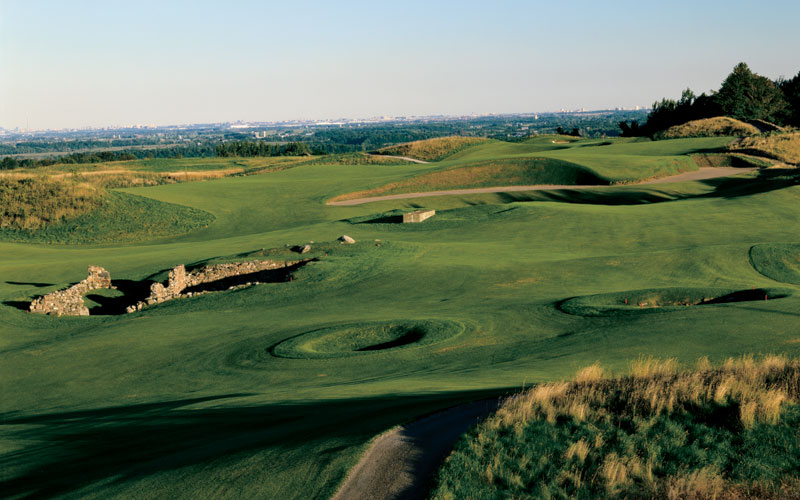
The par-five eighth at the 'Brush', complete with its former barn foundation.
7. Please discuss the allure of links golf to you personally. Is it your favorite form of golf? If so, why?
I love links golf and have played a lot of the most famous links courses in the world. Courses such as Royal Melbourne, Royal Dornoch, St. Andrews, Shinnecock Hills etc.., just touch the soul for golf purists. That being said I don’t have a favorite form of golf. I know that in this forum that answer might not be popular but I love many of the modern courses just as much as the links courses. Courses such as Shadow Creek, Gozzer Ranch, and Calusa Pines etc.., appeal to me just as much. To me, these courses are just different and that doesn’t make one type of course better than the other. I like many different styles and courses designed by many architects both living and dead. It’s one of the things that make my profession so interesting.
8. The site that became Devil’s Paintbrush had nice movement to it before you started your work. In the case of Calusa Pines, it too has become one of your most highly acclaimed designs yet much of its rolling topography needed to be created. How did you go about creating such interesting land movement all while making it look rooted in nature?
About 10 years before Calusa Pines was built the area that is now holes 8 – 12, and 15 “ 17 had a forest fire so the vegetation was very small. During the planning process we decided to make the course look different from other courses in the area by creating a large fill in this area. Without my background with Andy Banfield of the Fazio organization and learning how to move massive amounts of fill I doubt Calusa Pines would look anything like it does today. Andy really taught me to think big and, if you are going to create a large landform, to really make it as large and as bold as possible. Further, he taught me that you need to import massive amounts of vegetation to landscape the earth form so it looks as if it has always existed. The vegetation used at Calusa Pines was the same types that existed on the site before the fire and the size of some of the transplanted trees was hard to believe. However, this is what gives Calusa Pines the feeling that it was natural. Many people find it hard to believe those 45 foot fills were created.

The par three sixteenth at Calusa Pines.
9. Describe a favorite hole at Calusa Pines and what you like so much about it.
I would say my favorite hole at Clause Pines is #3. It is a par 3 that plays anywhere from 120 yards to just over 150 yards. The tee sits on about 15 feet of fill which ties into the clubhouse and parking lot, while the green sits up in the air about 12 feet above natural grade. The tee shot plays over a natural area with palmettos that were left along with a huge sand scrub area left of the green. Although is usually is a very short iron shot, hitting and staying on the green is a real challenge. It is very visually intimidating and if you miss the green the recovery shot is incredibly tough. This hole proves that a hole doesn’t need to be long to challenge a good player.
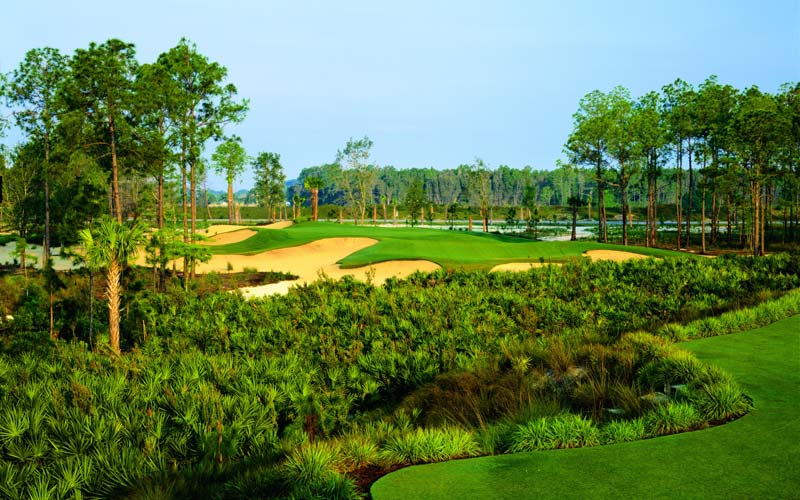
The beguiling par three third at Calusa Pines, whose short grass right poses as much challenge as the bunker left.
10. Given that some of the courses we have discussed (Devil’s Pulpit/Paintbrush and Calusa/Naples National) are in relative close proximity, how do you create differentiation so that the golfer never thinks he has already seen the design before?
With theses four courses it was actually pretty easy for numerous reasons. The Pulpit was a very severe site and massive amounts of dirt were moved to make the course playable. The Paintbrush was a great natural site. We moved very little dirt with the exception of the area around the irrigation pond, which we had to build for water storage. In fact that is my only regret at the Paintbrush. I wish the course didn’t have a pond at all, but we only had 160 acres to work with and we needed the water storage badly. At Naples National we were only permitted to dig 20 acres of lakes on the property which could be no more than 20 feet deep. That is why that course is so low profile. Calusa Pines was a very flat site like Naples National but we had over 500 acres to work with. During the construction of the course the owner, Gary Chensoff, was diagnosed with a very serious form of cancer. He simultaneously had an operation and started construction the course. The entire project became a larger than life experience and everyone involved wanted it to be the best it could be for Gary’s sake. From our initial plans we added a substantial amount of grading and today Calusa Pines has grade changes of almost 50 feet. So, although the sites were close together, due to different factors such as budgets and clients expectations the courses look very different from one another. The best part of Calusa is that Gary is in great health, to this day, to enjoy it.
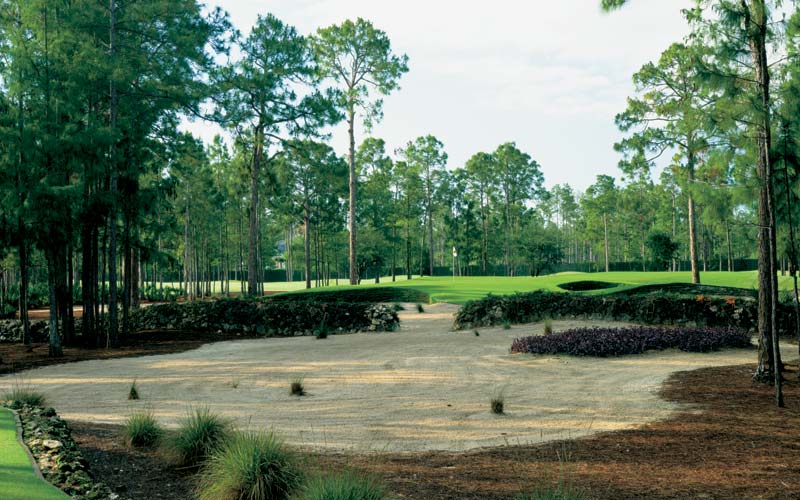
Calusa's nearby neighbour, Naples National.
11. What was the genesis of the collaboration with Ron Whitten at Erin Hills?
Ron and Mike Hurdzan have been friends for over 30 years. Both of them knew about this project from the request for proposal that had been put out. Mike asked me one day if I thought it would be a good idea to ask Ron if he would like to be involved with us as part of the design team. I had no problem with that at all. So Mike asked Ron and he was immediately intrigued. Ron had previously spoken to the editor of Golf Digest about getting involved in golf course design. He was told that would be okay but that any course he was involved with would not be eligible for any Golf Digest Awards. The owner really hit it off with Ron and Mike and said he didn’t care about the awards he just wanted the best course possible. I can’t stress enough how a big part of the team Ron was with us. He made dozens of visits to the site during the planning stages and was on site almost every single week during construction. Like everyone involved, he put his heart and soul into Erin Hills. It really was an experience none of us will soon forget.
12. Of which aspect of Erin Hills are you the most proud?
I would say the thing I am most proud of is the teamwork demonstrated by everyone involved in the project. Everyone was able to check their ego at the door and work together masterfully. It is a special place and I believe a lot of golf history will be made there in the future.
13. How conscious were you during the design and construction of Erin Hills of the desire to host the US Open and did you do anything differently than you would have done for a course without such an ambition?
Just after we got started in construction some people from the USGA visited and were immediately awed by the site and all of the open areas around it. They envisioned spectators around the course the way developers envision homes. The more we constructed the more their interest grew and Erin Hills was awarded the 2008 U.S. Women’s Publix. As the golf course was planted and growing, so was talk of a U.S. Amateur and possibly an Open. To make that possibility even more attractive, the owner Bob Lang asked us to make some revisions to the course that started in October 2008. Needless to say, we were happy to make the course more U.S. Open friendly. The only thing I would say we did differently than normal would be to stretch the course out so that if the USGA decides to host an Open it will have great flexibility. If they decided to go all the way to the back on every hole they could play it at over 8000 yards. Now, I don’t believe they would ever do that but the great thing is that they have the ability to make the course play whatever distance they like. The other thing we did was make numerous areas of 1 to 2% slopes in the putting surfaces so they could have several hole locations. In fact a few of the changes we did last fall included increasing those areas on a few greens.
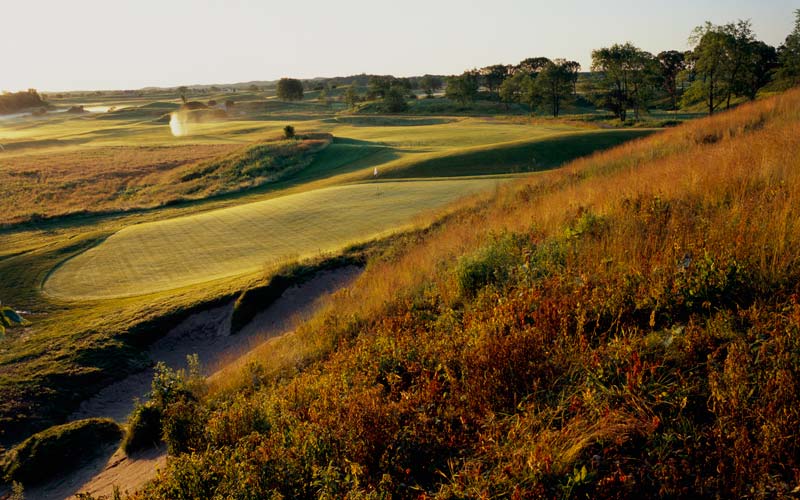
Of Erin Hills, Fry says: 'The natural contouring of Erin Hills allowed us to truly find golf holes. The fourteenth hole is a good example of this.'
14. A lot of emphasis is placed on the physical appearance of bunkers. Your bunker work is not easily stereotyped. Please provide us with photographs of three different bunker Ëœstyles’ and why each one works on its own particular course.
Bunkers to me are what completes a course and in many cases are what people remember the most. I have tried very hard the last 20 years to constantly change the style of my bunkers and not have repeating themes. At various times I have done sod wall bunkers, bunkers with very high flashed sand faces, bunkers with low sand and grass faces, bunkers with very soft edges and bunkers with ragged edges. I love trying new styles and hope I continue to do this in the future. Below are four different bunker styles that I have tried in the past.
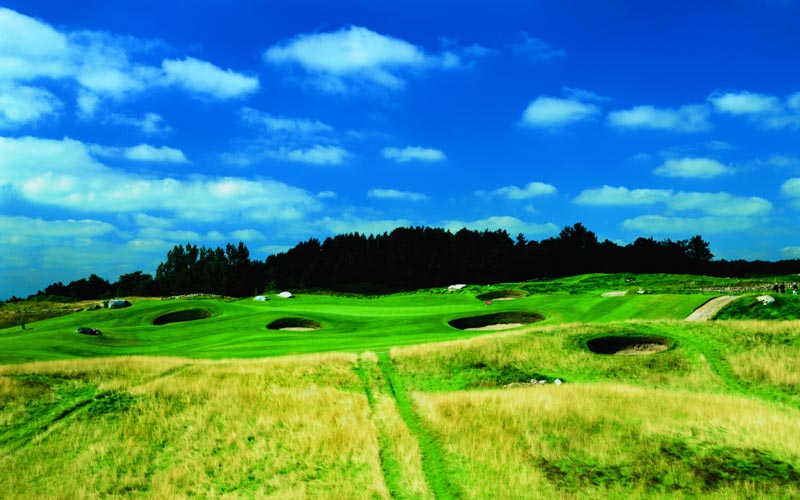
At the Devil’s Paintbrush all the bunkers are sod walls with the exception of a few which we built using railroad ties. To me, the riveted bunkers fit the site perfectly. There are very few trees and the gravel and sandy soil was perfect to create a course with that links feel. If I had to pick my favorite course I ever worked on this would probably be it. Combining the awesome natural topography, wild putting surfaces, great off site views and the sod wall bunkers to top it off makes the Paintbrush an experience I will not forget.

The bunkers at Hamilton Farm are just like the golf course, very big and very bold. The course has 73 bunkers, but if you asked most people they would say it has far more than that. I believe that’s because they are so large and as you are playing the hole, what is actually one bunker looks like several. The bunkers have fingers coming into them from all directions with very high flashes in between them and in those flashes seem to defy gravity. This is the course where we started using the first generation of bunker lining material called Bunker Wol. The superintendant at the time wanted to try and use it to help hold the bunker sand in place during a rain event. After we had the first few holes grassed a hurricane came through and, in one night, over 10 inches of rain fell. All kidding aside, on the second hole the front right greenside bunker, which probably has the highest faced sand I have ever built, had all the new sod slide into the bunker while the sand stayed in place. After word of this spread many other architects started using different types of bunker liners. The bunkers at Hamilton Farm are the hallmark of the course for their uniqueness.

The bunkers at Calusa Pines seem to rise from the ground and go on forever. There are over 20 acres of waste area which seems like nothing more than the native sand coming out of the ground and winding throughout the course with one side blending into native vegetation and the other side blending into the Bermuda grass. Because of the extreme contour changes at Calusa Pines, some of the bunkers have sand flashes up to 20 feet high. It is visually very dramatic and unlike anything else in Florida. I think the thing most people take away from their experience at Calusa Pines is that it feels like it fits into the natural landscape even though they may know it is manmade.
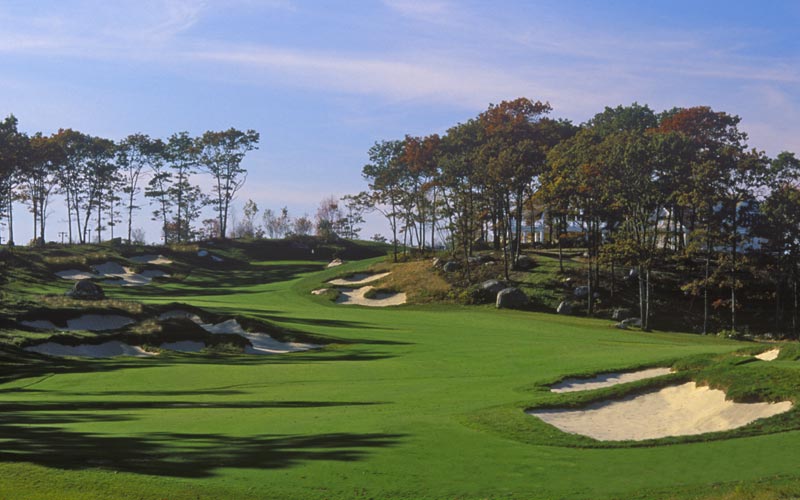
The bunkers at Shelter Harbor have a little story behind them. One day I got a call from Bill Coore who is a good friend of mine. He wanted to know if I ever would use one of the guys that worked on several of his projects. Bill said this guy had a real talent for building bunkers. His name will be familiar to most people here – Jeff Bradley. As it turned out we were just getting ready to start a new project in Rhode Island called Shelter Harbor and Jeff was working up at Old Sandwich outside Boston for Bill. I met with Jeff and we hit it off. Obviously I had seen and played almost every Coore & Crenshaw course and like most people I loved the bunkers. So when we put it out to bid I made it clear to all the contractors to price using Jeff Bradley into their bid. Landscapes Unlimited got the job and the hired Jeff to build the bunkers. Saying I learned a lot from Jeff would be an understatement. I would have the shapers rough them in and Jeff would finish them off. In some cases I would have 1 bunker roughed in and I would come back and he would have turned it into 3 or 4 bunkers. In some cases he would add a bunker where I had none. There was a lot of give and take between us and I hope we both learned from each other that there are several different ways and viewpoints as how to do things. The bunkering that Jeff built at Shelter Harbor fits so well into the natural landscape. The area was loaded with native grasses, rocks, rocks and more rocks. Jeff made the bunkers seem as if they had been their forever. Jeff really is a very talented guy and it was a learning experience that I will remember forever!
15. What three designs (none of which can be yours) have had the greatest impact on you as an architect? Why?
1) Sand Hills – Showing how great architecture on a great site should be!
2) Shadow Creek – Showing how, with great imagination and lots of money, a great site and golf course can be created!
3) Chicago GC – Showing how great architecture on a good, but not great site, can be amazing! One of my all time favorites.
16. In your most recent travels, what international courses surprised you most?
The most recent surprise I had was visiting Tom Doak’s course in Australia. Named St. Andrews Beach, it had been shut down because of financial problems. The bank owns it now and has only has one employee taking care of the greens and tees. They had let everything pretty well go. It was heart breaking to see but what a wonderful golf course it was and hopefully someone will bring it back. It is too good of a golf course to just let slip away! Also, I’ve had the chance to see Kingsbarns in Scotland. Great visually, fun to play with a variety shots required. I also toured The Castle Course at St. Andrews before it opened. Visually very dramatic but it looked like it may be difficult to play. The shots into the greens looked to be very challenging due to angles that you had to play from, but I wouldn’t rate it before I get the opportunity to play it. I guess the biggest thing that has surprised me so far is the quality of golf in Asia. I have probably seen close to 50 courses in the last few years but I haven’t seen many top quality ones. I am sure that in the near future that will change with all the architects that are working in that region now.
17. How do you keep learning new things in the field of architecture?
I try to visit numerous golf courses during my travels. When I first met Andy Banfield, he stressed how important it was to look at not only great old courses but new ones as well. I have always remembered that and have been doing that for over 25 years now. By visiting many courses you continuously see new and different things. The most important one being that there are many different ways to design and build a course. Seeing how different architects design their courses has been a great learning experience for me and I hope it will be that way in the future.
18. What’s an example within a design whereby you took a risk and that time has shown it to be the right decision to have Ëœpushed the envelope’?
I would say Calusa Pines is a good example of pushing the envelope. It looks nothing like any of the other 200 courses in southwest Florida. We moved over 1.7 million cubic yards of dirt and created a course with almost 50 feet of grade changes. Many people considered it to be one of the top courses in the state. In addition to people talking about the clubhouse and its setting, service, and ambiance, most people rave about the approach shots into the greens, contours in the greens, and course conditioning. Most believe the elevations are natural but I firmly believe that without creating such big earth movement it would be just another typical course in south Florida. Sometimes to create something special you must take a chance and be different.
19. In this brutal economy, every penny counts. Where do you see the most waste of money by clubs on their courses?
Well until recently that would have been an easy answer ¦ ¦ ¦course conditioning. The standards to which golf courses were maintained got out of control. Most clubs wanted everything green all the time, fast greens every day, bunkers that were very firm and gave perfect lies. Now, because of the economic situation, things will really change and in many cases, for the better. I am sure almost all clubs will reduce their maintenance budgets and hopefully reduce their maintained turf areas. This will also hopefully get more courses to become less concerned with being green and allow them to play firm and fast. By far the biggest waste was in the clubhouses. They were way too big, took too many people to operate and cost too much to staff. Clubs are trying to get leaner but with an existing big clubhouse it is a problem that I don’t know how to fix.
20. The slowdown in the United States has caused many North American architects to look a) globally and b) at restoration work. Is either of these areas where you think Hurdzan & Fry might concentrate?
a) I made my first trip outside the U.S. to look for work 3 years ago due to the slowdown in the U.S. Now over 90% of our work is outside the U.S. Currently we have projects in various phases of design and development in China, South Korea, Thailand, Costa Rica, Italy, Portugal and France. In the last 6 months work has slowed down everywhere but, long term, new golf development will grow in many new emerging markets. It takes a tremendous amount of time, effort and money to become established in a new market.
b) Our company has done many renovation projects thru the years and we continue those to this day but we have never done what I consider true restoration work.
21. As a GOLF Magazine panelist that selects the world’s best courses, does it influence your in the dirt work?
I wouldn’t say it directly influences it but it is in the back of your mind. When I am designing a golf course I am trying to put in the ground the absolute best golf hole I can. In many cases due to site constraints, budgets or clients goals you can’t even think Top 100 but when you are working at a place like Erin Hills, Calusa Pines or the Devil’s Paintbrush you know that you have a chance. As a golf course architect those chances are what you dream about.
22. What effect do magazine rankings have on your profession?
It is very important to an architect’s career today. It gives you more credibility, helps get your name out in the public, can assist in finding more jobs and can help you get higher design fees.
23. What three courses would you vote in the world top 100, which you doubt your fellow panelists do?
1) I have always rated Paraparaumu Beach in New Zealand in the Top 100. I believe in the last ranking it dropped out and that could be due to Tom Doak’s new course in New Zealand called Cape Kidnappers. The reason I always rated Paraparaumu so high is the great variety of holes both long and short. It demands great shot making, and was all done on a very compact sight. To this day it is still the best links course I have seen in the southern hemisphere.
2) Gozzer Ranch in Coeur d’Alene, Idaho. A new Tom Fazio course that I am very familiar with. I first saw this property in the mid 90’s and was hired by the owners. Our company over the next few years did several routing plans and I walked the site several times. Eventually a lawsuit between the owners occurred and the project was eventually under the control of just one of the previous owners. Making a long story short they partnered up with Discovery Land Development Company and they hired Tom Fazio. I have seen virtually every course the Fazio Design team has turned out and this maybe their best golf course ever. The course fits into the natural surroundings beautifully, the views are amazing, and the course has a great variety of golf holes. The bunkering is the best his company has ever produced. It is a fantastic place and I believe it deserves to be in the Top 100.
3) St. George’s Hill in Weybridge, England. I have only played this course one time about 15 years ago but it has always stuck in my mind as one of the world’s great golf courses. I also believe it could be Harry Colt’s best work. The course consists of 3 very different nine hole loops, with really good topography, which varies from very gentle to very dramatic. Simply put this course is aesthetically one of the most beautiful inland courses I have ever seen. The course requires great demands on your shotmaking and you will find it difficult to see many courses that have the variety of holes St. George’s Hill has, or a place where you will enjoy a round of golf more. Indeed it is a very special place.
The End








